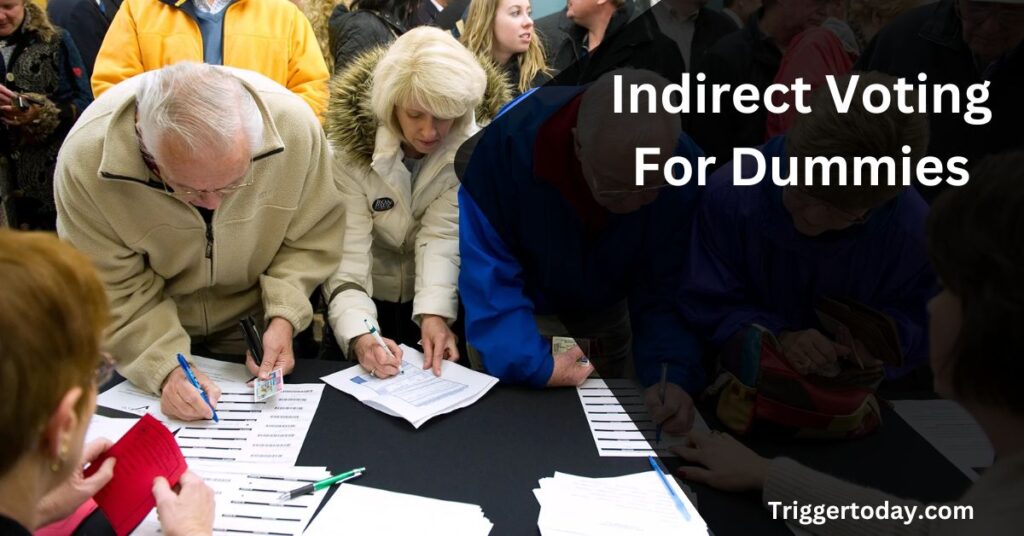Indirect Voting For Dummies – A Simple Explanation!

Navigating indirect voting for the first time felt like trying to solve a complex puzzle. I remember feeling overwhelmed until I found a guide that broke it down into simple, relatable terms. It made all the difference, turning a confusing process into something manageable and even interesting!
Indirect voting for dummies offers a straightforward, easy-to-understand guide to this complex electoral system. It simplifies how indirect voting works, making it accessible for beginners. Ideal for anyone looking to grasp the basics without the confusion.
In this article on “Indirect Voting for Dummies,” we’ll explore the basics of how indirect voting works and its historical roots. We’ll also discuss its advantages and disadvantages, and provide real-world examples from various countries.
What Is Indirect Voting Vs. Direct Voting?
- Direct Voting: In direct voting, citizens vote directly for candidates or specific issues. For example, when you vote for a presidential candidate or a new law on the ballot, you’re participating in direct voting. It’s a straightforward process where your vote directly impacts the outcome.
- Indirect Voting: In indirect voting, citizens vote for representatives who then make decisions on their behalf. For instance, in the U.S. presidential election, voters choose electors through the Electoral College who then vote for the president. This method involves an extra step where elected representatives or delegates make the final decisions.
In essence, direct voting means your vote directly counts towards a result, while indirect voting involves selecting others to make decisions for you.
How Does Indirect Voting Affect Government Decisions?
Indirect voting influences government decisions by creating a multi-step process where elected representatives or delegates make the final choices rather than citizens directly. Here’s how it works:
- Delegated Decision-Making: In an indirect voting system, voters choose representatives (such as legislators or electors) who then decide on policies or select officials. This means that the representatives you elect are responsible for making decisions and shaping laws based on their judgment and expertise.
- Streamlined Process: By having representatives handle decision-making, the process can be more efficient, especially in large or complex societies. These representatives often have the knowledge and experience needed to make informed decisions, which can help in managing intricate issues more effectively.
- Representation of Diverse Views: Indirect voting allows for a broader range of opinions to be represented. For instance, in a legislative body, representatives from various regions and backgrounds contribute to decisions, ideally reflecting a wider spectrum of public interests.
- Potential Disconnect: One drawback is that voters might feel less connected to the decisions being made. Since they are not voting directly on every issue, there’s a risk that their preferences might not always align with the outcomes decided by their representatives.
- Checks and Balances: Indirect voting can also introduce a system of checks and balances. Representatives can debate and review decisions before finalizing them, which helps ensure that decisions are well-considered and not made impulsively.
In summary, indirect voting impacts government decisions by delegating decision-making to elected officials who are expected to represent the electorate’s interests, potentially making the process more efficient but also creating a layer of separation between voters and the outcomes.
What Are The Historical Origins Of Indirect Voting?
Indirect voting has its roots in ancient history. In the Roman Republic, citizens elected representatives to speak on their behalf in government, marking an early example of indirect voting. This system allowed for a more manageable way to govern a large population by having a smaller group of representatives make decisions.
The concept evolved over time, particularly during the Enlightenment in the 17th and 18th centuries. Thinkers like John Locke and Montesquieu argued that elected officials could better handle complex political issues than average citizens voting on every detail. Their ideas influenced the development of representative democracies.
By the 19th century, many countries adopted indirect voting systems to balance the need for public input with effective decision-making. Today, indirect voting continues to be used in various forms around the world, reflecting its historical evolution from ancient practices to modern democratic systems.
Why Do Some Countries Use Indirect Voting?
Some countries prefer indirect voting because it helps manage large populations and complex governance more effectively. Here’s why:
- Efficiency: Indirect voting streamlines decision-making by having elected representatives or delegates handle detailed and intricate issues. This makes the process quicker and more organized, as representatives can focus on complex matters rather than every individual citizen needing to vote on each issue.
- Expertise: Representatives chosen through indirect voting often have more knowledge and experience in governance. This expertise can lead to more informed and thoughtful decisions on policies and laws.
- Representation: Indirect voting allows for a diverse group of elected officials to represent various interests and viewpoints. This can help ensure that different regions and demographics have a voice in the decision-making process, even if voters don’t participate directly in every decision.
- Complexity Management: For large or diverse nations, it’s impractical for every citizen to vote on every issue. Indirect voting helps manage this complexity by delegating decision-making to a smaller group of representatives who can debate and decide on policies.
In summary, indirect voting is used to improve efficiency, leverage expertise, ensure diverse representation, and manage complex governance processes more effectively.
Can Indirect Voting Reduce Public Representation?
Yes, indirect voting can sometimes result in less direct representation of the public’s interests. When citizens use indirect voting, they choose representatives who make decisions for them, which can create a gap between what people want.
If these representatives don’t fully understand or reflect the views of their constituents, the policies and laws they create may not match. Additionally, if voters feel disconnected from their representatives or think their opinions aren’t being considered, they may become disengaged from the political process.
What Are The Advantages Of Indirect Voting?
Indirect voting has several advantages:
- Efficiency: It streamlines decision-making by allowing a smaller group of elected representatives to handle complex issues. This means decisions can be made faster and more effectively, especially in large or diverse populations where it’s impractical for everyone to vote on every issue.
- Expertise: Representatives chosen through indirect voting often have more experience and knowledge about governance. They can use this expertise to make informed decisions and navigate complicated problems better than the general public.
- Broad Representation: Indirect voting allows for a wide range of viewpoints to be represented. By electing officials from different regions and backgrounds, the system ensures that various interests and concerns are considered in the decision-making process.
- Focus on Big Issues: It enables voters to focus on broad policy goals and trust their representatives to handle the details. This can prevent voters from getting bogged down by every small decision and instead engage in more meaningful discussions about major issues.
Overall, indirect voting helps manage complex governance, leverages specialized knowledge, ensures diverse representation, and simplifies the voting process for the public.
What Are Examples Of Indirect Voting Systems Today?
In the United States, the Electoral College is a clear example of indirect voting. Citizens vote for electors, who then select the president. This means the final choice of president is made by these electors, not by a direct public vote.
Similarly, in India, members of the Rajya Sabha, or Council of States, are elected by state legislatures rather than through direct public voting. This allows state representatives to choose their counterparts in the upper house of Parliament.
Germany uses the Bundesrat as an indirect voting system where federal states appoint members to represent their interests nationally. In Italy, the President is elected by an assembly of members from both houses of Parliament and regional representatives, not through a direct public election.
Frequently Asked Questions:
How Does Indirect Voting Influence Legislative Processes?
Indirect voting allows elected representatives to debate and decide on legislation, which can streamline decision-making and incorporate expert opinions. This often results in more thoughtful and detailed laws compared to direct voting by the general public.
What Role Do Delegates Play In Indirect Voting Systems?
In indirect voting systems, delegates are elected to represent the interests of their constituents. They are responsible for making decisions or voting on behalf of the people who elected them, often in a legislative or electoral college setting.
How can indirect voting systems impact political campaigns?
Political campaigns in indirect voting systems often focus on persuading and influencing key representatives or delegates. This can lead to targeted strategies aimed at winning over decision-makers rather than the general public.
What Are The Challenges Of Indirect Voting For Voters?
Voters in indirect voting systems may feel disconnected from the decision-making process, as their influence is mediated through representatives. This can lead to frustrations if the outcomes do not align with their personal preferences or needs.
Conclusion:
Understanding indirect voting is crucial for grasping how representative democracies function. By learning how this system works, you gain insight into how decisions are made and how your vote influences the process indirectly. This knowledge empowers you to engage more effectively in democratic practices.




